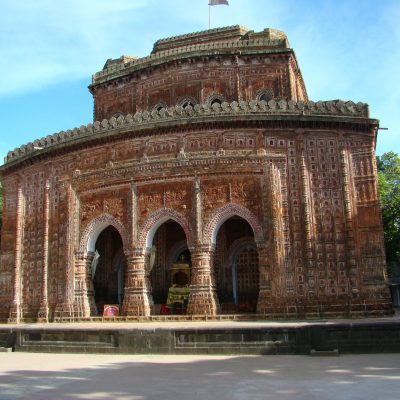
Kantajew Temple
The Kantajew Temple is one of the most magnificent religious structures belonging to the 18th century of Bangladesh. This is one of the greatest terracotta examples of the country, once this had nine spires but it was destroyed by an earthquake of 1897. The structure is called by Kantajew temple, this late medieval Hindu temple is situated in north-western part of Bangladesh, in Dinajpur. The temple belongs to hindu kanta or Krishna, most popularly in the assemble of the love story of radha-krishna temple of Bangladesh. The temple is dedicated to Krishna and his wife Rukmini, this is one of the greatest terracotta temple of Bangladesh.
Maharaja Prannath started the construction in 1722 AD. His adopted son Maharaja Ramnath completed it in 1752 in order to fulfill his father’s wish to adapt the temple of Radha-Krishna. In the earlier 20th, Maharaja Girijanath Bahadur restored it, though he couldn’t adopt the nine pillars as those were destroyed by the earthquake.
Though there are some confusion regarding the making of this temple. From the record of chronogram in Sanskrit stone inscription, it records that the construction started at 1722. So the date is believed that the construction started at 1722.
Navaratna style was followed by in the making of this temple. The nine spired temple was a magnificent heritage of this country. Wide multi-cusped arches of this temple is wonderful and the characteristics features of the erections are four centered. The ornamental turrets on the either side of the fronton and the semi-octagonal mirirab apertures are beautiful. The archway opening under half-domes and the Persian muquarnas work in stucco inside the domes were placed. Domes on octagonal drums with lotus and kalasa finials as the crowning elements are there. The round pendentives for the domes and the multi-faced corner towers are beautification of the temple.
The temple was built on a beautiful pyramid style with three receding terraces. Nine ornamental Ratnas or spires on the corner of the three terraces. A huge Ratna was on appearance on a high plinth. To enable devotees to see the deity inside from all directions, it was provided with arched openings. This stands in the center of an oblongcourt enclosed by a pilgrim shed. A 1 miter high plinth of stone is under the roof. Small square cells at each of the four corners of the ground is there and first floors for supporting the heavy load. This magnificent temple accommodates four rectangular corridors. On the ground floor, three multi-cusped arched entrances are there. The staircase is built by a narrow strip. A single spired temple is now overgrown with rank vegetation. It stands about one hundred yards north of the main temple beyond the pilgrim shed. It was erected by Maharaja Prannath. He brought the Krisna Icon from Brindabon and later it was transferred to nava ratna temple.
Floral terracotta in unbroken succession is the most amazing part of Kantajew temple. The terracotta area covers the stories of Ramayana and Mahabharata, the stories of Krishna and a series of fascinating contemporary social scenes. The terracotta part is not only a part of beautification but also a series of stories of myth and religious texts. The structure modelling, beauty and the positions of terracotta are truly amazing and magnificent in looking. Religious stories are portrayed nicely in the terracotta, the temple has the most beautiful terracotta design in the country. The walls of the temple are of a totally different nature from the other terracotta works of the country. In Pala dynasty of 7th century, has some similarities of the works. A very magnificent scheme of decoration is found here with a sophisticated mature art.
The ndless panels of the kantajew temple have a life and style of their own. It’s unlike south indian temples and of odissa’s. Here the development of an indigenous terracotta art is said a logical artform of that time. Different types of deities are there, in the terracotta. With several deities and their stories, the terracotta looks magnificent and makes a wonder of our country. For any archaeologist, the temple is a sign of wonder and a sign of magnificent art work. People from all over the country go to visit the temple to explore this magnificent beauty of art.
Buses are available from Dhaka to Dinajpur. Get ona bus towards Thakurgaon, which will drop you to the nearest bus station. Then you will have to hire a rickshaw to reach there. If you are from Rangpur, take a bus towards Dinajpur and get off at Dosmail stoppage. From then, hire a CNG to reach the temple.
The temple does not require any entry fee but need a parking fee of 20 taka. There is no entry time or schedule. You can enter at any moment you want to.
